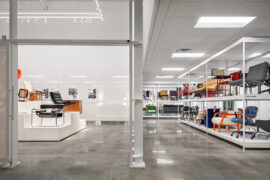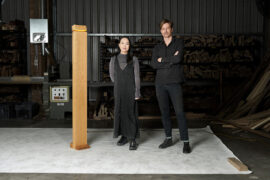Wilkhahn releases the mAx Table and Aula Chair to revolutionise the terms, conditions and experience of flexibility in the commercial environment.
People expect a lot from Wilkhahn. And having just celebrated its 111th anniversary, it’s not hard to see why. Wilkhahn remains one of contemporary design’s most unflappable brands, continuing to innovate year upon year for more than a century. A leader in the commercial furniture industry, the brand welcomes two new additions to its exhaustive portfolio: the mAx Table and the Aula Chair.
Desgined by Wolfgang C.R. Mezger, Wilkhahn‘s Aula Chair is a stackable, multi-purpose addition to the Australian commercial sector’s demand for flexible design solutions. Taking plastics to a new horizon of functional and aesthetic profiles, Aula’s delicate lines and precise sculptural form offers designers an immensely movable and space-conscious alternative to generally mono-purpose ergonomic seating. Available in up to sixteen colurways and four upholstered options, Aula’s seamless structure offers a high degree of sacral and lumbar support to ensure that Australia’s workforce is as healthy as it is productive.
Meanwhile the brand’s mAx Table – designed by Andreas Störiko – reinterprets the relationship between users and their tools. No longer seeking to fit the body to the workstation, mAx’s self-stabilising functionality responds to user movement and need intuitively. As a folding table system, mAx’s vital, essential form offers the commercial sector a truly flexible and multi-purpose option to a variety of worker needs and behaviours. In response to local demands for more amenable furniture to break out zones, end of trip facilities and impromptu collaboration hubs, mAx’s T-shaped foot section ensures sturdiness and durability across a mix of applications. When coupled with with mAx’s variety of table depths and forms, the system can be arranged in loose configurations or linked together for more uniform continuity.
Thanks to the establishment of Wilkhahn Asia Pacific – the brand’s full-scale operation responsible for locally manufacturing Wilkhahn products for the Asia market, initially developed in Germany – an approximate eighty per cent of Wilkhahn product supplied to the region is hails from their state-of-the-art facilities in Riverwood, Australia. Having achieved this significant milestone, Wilkhahn now looks forward to operating its complete network of service centres in Asia Pacific – realising new methods for lead time reduction and a truly responsive service model to all local markets throughout the region.
INDESIGN is on instagram
Follow @indesignlive
A searchable and comprehensive guide for specifying leading products and their suppliers
Keep up to date with the latest and greatest from our industry BFF's!

The undeniable thread connecting Herman Miller and Knoll’s design legacies across the decades now finds its profound physical embodiment at MillerKnoll’s new Design Yard Archives.

For Aidan Mawhinney, the secret ingredient to Living Edge’s success “comes down to people, product and place.” As the brand celebrates a significant 25-year milestone, it’s that commitment to authentic, sustainable design – and the people behind it all – that continues to anchor its legacy.

In Australia alone, 6.4 per cent of all waste generated comes from furniture and furnishings. In this article, we review today’s most impactful Whole Of Lifecycle Furniture practices.

Globally recognised environmental pioneers Wilkhahn are once again taking bold strides forward in the name of sustainability. The award-winning Yonda collection is their magnum opus of design circularity.
The internet never sleeps! Here's the stuff you might have missed

Celebrating ten years of creative impact, Melbourne Design Week 2026 invites designers, studios, and collectives to submit expressions of interest for its statewide program and the Melbourne Art Book Fair.

AHEC’s KEEP exhibition at Cult Sydney sees six Australian architects craft lasting furniture pieces, on view until 4th October.